Abstract
The net value of urban agriculture has not been studied, especially accounting for the cost of water. This study has sought to remedy this gap in the literature by examining the varying price of water in different climates. A two-stage linear programming model has been used to maximise the net value of urban agriculture. The decision variables included the type and yield of crops; constraints included upper and lower bounds of dietary food groups, individual foods, protein and energy as well as area utilised per person. The results show optimal crop regimes are similar across different climates and water prices due to the selection of crops that have high profit margins. The results also showed that per capita garden size is critical with smaller gardens optimal in terms of water applied per unit area and net value returned as well as return per unit area due to the ability to select the highest value crops. Generally, the more high-value and low water-use crops that can be included, the higher the value in larger gardens. The results indicate that a modest food garden growing the right crops can be highly cost-effective, even with conservative crop yields and water use.
1. Introduction
Small-scale food production in cities has long been popular for a variety of reasons, including the perceived ability for “home-grown” produce to reduce food costs [1,2,3,4]. Unfortunately, it is not known how effective urban food production is at actually delivering a real cost saving. Data on typical garden yields and inputs are scant [5] and in some cases [3,4] the potential savings from food gardens appear to be calculated by simply considering the gross retail value of garden produce without accounting for the cost of any inputs.
Sanyé-Mengual et al. [6] presented a thorough analysis of environmental and economic costs of production for an experimental rooftop greenhouse, considering yields and inputs, but did not relate their findings back to the question of whether this form of urban agriculture (UA)—or UA as more commonly practiced in gardens—can significantly reduce food costs. If food gardens are to provide real reductions in food cost to those who need it most (for instance, low-income households) it needs to—at the very least—be profitable, meaning crudely that the value of outputs must outweigh the cost of inputs.
van Veenhuizen and Danso [7] identified the high price of clean water in cities as one of the key factors distinguishing urban from rural agriculture in the developing world. However, in studies of UA in the developed world, the cost of water is frequently neglected as an input to production. For instance, in a highly-regarded “how to” guide on profitable urban farming [8], it is claimed that the ubiquity of reticulated water in cities gives urban producers an advantage over their rural counterparts, and that water rates are rarely high enough to cause concern.
Ward et al. [5] explained that a significant reason for the lack of data on actual water use in urban food gardens is that metered water use tends to be aggregated with adjoining buildings. They went on to model realistic crop water requirements in several Australian cities and found that, at market rates for urban water, in some cities the cost of irrigation water alone may outweigh the value of garden produce. They found that the viability of UA in dry climates (such as cities in southern Australia) faces a double threat from high water prices coupled with high crop water requirements. In contrast to these findings, a much earlier, field-based study from the United States [9] found that appropriate gardening could yield a substantial return on the money spent on irrigation water, even in a desert climate (Tucson, Arizona). Ward et al. [5] acknowledged that their negative results may reflect the fairly recent phenomenon of sharply rising urban water prices in Australia.
Figure 1 compares water pricing for two Australian cities (Hobart and Adelaide, respectively the best- and worst-performing cities in the analysis in [5]) against water prices for Tucson, Arizona in 1983, the time of the field experiments reported in [9], as well as present-day tiered pricing [10]). Stepped pricing schemes (such as in Adelaide and Tucson) are now common, where consumers pay the lowest rate for the first few kilolitres (kL), then step up into higher rates as they consume more over the billing period. It is evident that the water price at the time of [9]—in inflation-adjusted terms—was low (approximately US$0.84/kL in 2013 dollars using U.S. CPI data). Interestingly, the 1983 water price in Tucson is almost identical to that in present-day Hobart (Australia), where [5] found irrigation costs were low enough to maintain garden profitability. In Tucson, if overall household consumption could be kept within the first and second tiers, then the cost (in real terms) of irrigating gardens today may be similar to 1983. On the other hand, if garden irrigation pushes consumption into the third tier, then coupled with the extremely dry climate, irrigation could be even more expensive than in Adelaide.
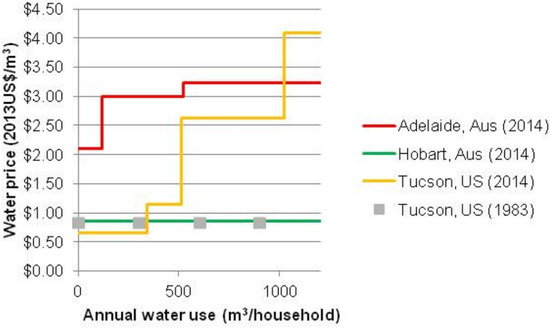
Figure 1.
Comparison of mains water prices in two Australian cities assessed by Ward et al. (2014a), against prices in Tucson, Arizona in 1983 (inflation-adjusted price from Cleveland et al., 1985) and present-day. Billing periods are quarterly in Adelaide and monthly in Tucson.
It is important to note that the Arizona study [9] did not seek to maximise profitability; they merely attempted to demonstrate that food gardening could be cost-effective even in very dry climates. Contemporary proponents of UA (e.g., [11]) promote growing boutique or niche crops (such as fresh herbs, gourmet salad greens, and bamboo) with very high retail value in order to maximise the opportunity for profit. Gladek [12] presented a visionary plan for a high-tech polyculture system that—whilst offering a variety of products such as fruits, vegetables, fish, chickens and mushrooms—was also strongly biased towards the production of high-value crops such as fresh herbs to maximise profitability. However, these cash crops are not expected to make a large difference to dietary food security [13], and have questionable relevance to the households with the greatest need for cost savings.
For urban food gardeners seeking to find the optimum crop mix (i.e., for maximum money savings), there is a clear need for a design method that delivers crops that are cost-effective and scalable, moving beyond the focus on high-value items. To be widely scalable, the new method should account for the full price of inputs, which should obviously include water—especially in cities with high water prices. The design should also deliver a selection of crops that fits within the context of a balanced diet, in order to avoid over-supply of niche items. This is recognised by Satzewich and Christensen [8], albeit from a different perspective; they explained that small-scale commercial growers need to supply diverse produce (both high and low value) to meet the customer demands at the local farmers market. The reason for this is that UA growers, selling direct to consumers, can only serve a relatively small number of customers; therefore, to maximise the amount of produce that can be sold to these customers, the diversity should correspond to the demands of the consumer (which extend beyond high-value goods such as gourmet salad greens). A household attempting to reduce its food costs needs to do the same.
It should be noted that the question of garden profitability is not only relevant to gardeners and their households. In Australia, gardening is seen as a “discretionary activity”—i.e., a recreation that costs money [14,15,16]—which makes the garden and nursery industry vulnerable to broader economic problems affecting general discretionary spending. Although there is increased interest in home-grown food production, the industry has identified the increasing costs of inputs (including water) as key threats [17]. Demonstration of a method for designing scalable, genuinely cost-effective productive gardens should therefore be of great interest to these industries dependent on continuation of gardening activity in cities.
To address the need for optimal crop selection, we will make use of Linear Programming (LP). LP is a decision-making tool to select the combination of variables that either maximises or minimises a particular objective, subject to a range of constraints. The aim of this paper is to demonstrate the use of LP as a method for selecting the most suitable crops as part of the design of urban food gardens, subject to both a dry climate and high reticulated water price. We will investigate the similarities and differences in optimally-designed crop regimes when the gardens are designed for different climates and/or subject to different water prices. We will also investigate the significance of garden scale on cost-effectiveness and water-use efficiency.
2. Experimental Section
2.1. Method
The challenge of LP begins with defining an appropriate “objective function” and a set of constraints, all of which must vary in a linear relationship depending on the values of the decision variables. In the case of the productive urban garden, we can establish:
- A relevant objective: the total value of food produced in a garden of a specified area, minus the total cost of inputs
- A set of decision variables: the area to allocate to each crop type in the garden
- A set of constraints: minimum and maximum representation of dietary food groups (as well as energy and protein); land area available; total cost
We adopt a simplified model of urban food production based on the Land Use Diet Optimisation (LUDO) model [13]. The model uses straightforward relationships between yield (kg/m2/yr), growing area (m2) and consumption (kg/day) for a range of individual crops. Dietary information (protein, energy and food group category) is included for each crop, as well as retail value (Figure 2). The two inputs considered are fertiliser and water, which are costed for each crop to offset the retail value.
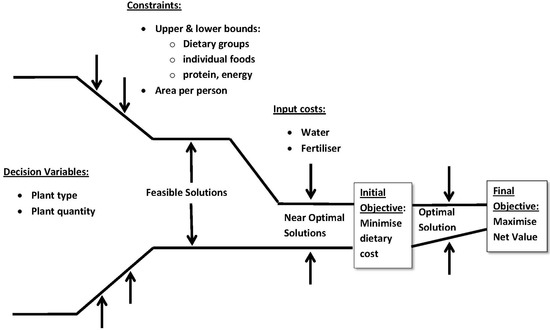
Figure 2.
Urban Agriculture Optimisation Model.
Labour was deliberately omitted from the analysis on the assumption that food gardening (in urban backyards in the developed world) takes place entirely as a discretionary activity, with little opportunity cost and with numerous social and health benefits articulated throughout the literature on this topic. Moreover, assuming a household has any garden (ornamental or productive), it will require labour to maintain. Likewise, capital costs are omitted on the basis that all gardens cost money to establish and maintain, irrespective of whether they are ornamental or productive. If the linear programming approach was to be applied to, for instance, the design of small-scale (commercial) urban market gardens, then capital and labour would necessarily be added as input resources and costs assessed appropriately.
The energy cost of pumping water depends on a number of factors that cannot be modelled without introducing a wide range of additional variables or scenarios—e.g., mains water (not pumped) versus rainwater (pumped or gravity-fed) versus groundwater. Efficiency of pumps and appropriate matching of pump to system requirements can be expected to vary significantly from garden to garden. It is likely that a lot more energy is expended on fuel- and transport-related garden activities (e.g., motorised cutters for weed and grass control, and travel to and from supply shops) than on pumping water. In order to maintain tractability, we have omitted energy in the current analysis but the modelling framework allows for the inclusion of energy, fuel or any other currently omitted input.
Although results will be reported on a yearly average basis, the model does include a temporal dimension, accounting for seasonality in terms of both the planted area and the dietary availability by dividing the year into four equal seasons. Crops are assumed to be in the garden (taking up space) for one or more seasons (rounded according to the typical length of the growing season) and available in the diet for one or more seasons (depending on the typical timing and duration of harvest, and ease of storage). Items imported from outside the UA zone are assumed to be available year-round.
For yields, it has been noted [18] that available figures on conventional urban gardening suggest yields are somewhat less than commercial rural agriculture, but that intensive urban gardening practices have reported yields potentially two to three times higher than rural [19]. Ward et al. [13] assumed typical gardens in a given country could be expected to achieve the national average yield for each crop, which is a conservative assumption that we will follow in the present analysis. However, to differentiate between local climates within a country, we will assume yield scales linearly with total growing period reference evapotranspiration (ET0) [20,21]. This is a crude assumption, but is introduced to avoid overestimating production and water-use efficiency in cooler climates. The reference yield (national average) is assumed to occur at the location with the highest ET0 for the growing period.
Fertiliser input is calculated based on the assumption of a uniform application rate across the growing area, and a widely used, commercially available fertiliser (pelletised chicken manure) was chosen to estimate the cost at the recommended application rate. Irrigation water requirement is calculated on a monthly basis for each crop, based on FAO56 crop coefficients [22] with monthly rainfall and ET0 data for the location under investigation. Because it is unlikely that gardeners would apply irrigation at the various theoretical FAO56 rates across a diverse mix of different crops in their garden, a simple method has been shown [5] to approximate a more realistic water application regime. In their method, water was assumed to be applied at a uniform rate to the whole growing area, equal to the single highest water demand crop planted in a given month. This approach is used in the current analysis and represents an improvement on the LUDO model [13]. Water is reticulated mains (drinking) water and can be expected to not vary significantly in quality or chemistry across the locations considered in this analysis.
To ensure food production is complementary to the broader diet, urban food production is nested within a whole diet by including various foodstuffs not produced in the garden (dairy, meat, cereals and discretionary foods). The inclusion of these broader foodstuffs enables the simulated urban production to be placed in the context of a realistic diet cost (which can be minimised by optimisation) to prevent the model recommending an urban cropping regime that results in higher overall food costs.
In LUDO, the decision variables are the quantity (kg/day) of each food type from each zone (garden or external) to be included in the diet. There are various objectives relevant to UA, and although it is not possible to simultaneously optimise for multiple objectives, there are ways to combine objectives and constraints in order to explore multiple objectives. The method applied here is to use two objectives sequentially, and represents a minor extension to the approach of [13]. The first objective is to minimise overall diet cost, which will be used to generate the context for the garden optimisation; this is essentially a “first pass” in order to avoid designing food gardens that only make sense in a high-cost dietary context. The subsequent objective is to maximise net value (retail value minus production costs) of garden produce. In this second optimisation, a constraint is imposed on overall diet cost, being close to the value obtained from the first objective. The cost constraint is set slightly higher than the least-cost diet obtained from the first optimisation, to provide the LP process sufficient numerical space to find an alternative solution.
A number of constraints are applied to ensure the optimised solution remains plausible. To ensure a balanced diet, upper and lower bounds are applied for: dietary food group representation (in accordance with [23]), individual foods (to provide a diversity of foods within each food group), as well as protein and energy [23]. In addition to the constraint on diet cost (derived from the optimisation of the first objective), a constraint is placed on the proportion of protein coming from the garden to ensure that the garden makes a substantial contribution to diet, and does not just save money. The composition of the diet changes throughout the year in response to the availability of foods produced in the UA zone; demand-driven dietary changes throughout the year are not considered.
The model has a number of assumptions and limitations. First and foremost is the lack of data regarding urban yield and water-use efficiency; these have been assumed based on commercial average yields and theoretical water requirements but there is a great need for data specific to UA operations. We expect our assumptions are conservative, as urban gardens should be able to deliver higher yields than commercial averages due to intensive stacking of mixed crops. The FAO56 irrigation requirement is applied using monthly averages based on a standard calculation procedure, but is modified upwards to account for a realistic watering regime (described above). This may be conservative as it does not consider effects such as mulching and wind protection that may reduce water use in urban environments [24]. Fertiliser use is very approximate but reflects the approach recommended by garden fertiliser manufacturers (i.e., a constant application rate).
The analysis is strongly dependent on the assumed retail value of food items. The database of prices came from late 2013 supermarket prices for items not “on special”; therefore, the analysis does not account for cost savings that can potentially be achieved by purchasing discounted items. However, this is taken to reflect the most widely scalable cost structure (i.e., it is not feasible for everyone to exclusively purchase items on discount all of the time).
All input data were collated in Microsoft Excel, and the linear programming was executed (within Excel) using the OpenSolver optimisation package [25].
2.2. Modelled Scenario
Three Australian weather scenarios were used for the current analysis: Adelaide, Mt. Lofty and Hobart. All are broadly considered Mediterranean. Adelaide and Mt. Lofty are in South Australia, and Hobart is in southern Tasmania (a large island off the south-east coast of Australia). Adelaide is the hottest and driest of the three locations and has expensive water (Figure 1 and Figure 3). Mt. Lofty is located immediately east of Adelaide and has the same water price structure; however, it exhibits a cooler, wetter climate with more than double the average rainfall of Adelaide due to increased altitude. Hobart is slightly wetter than Adelaide and has lower overall ET0, but is primarily included in the analysis because of its vastly lower water price. Figure 3 indicates the breakdown of monthly rainfall and ET0 for the three locations.
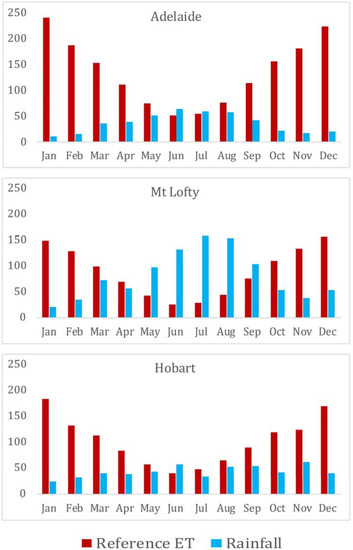
Figure 3.
Rainfall and reference evapotranspiration for the three locations being analysed.
Table 1 displays the foods included in the overall diet and shows which of these is considered able to be produced in the backyard garden. Items considered for inclusion in the diet are not exhaustive, but are sufficient to provide a broad dietary context (including discretionary items) that gives a relevant overall diet cost and nutritional profile, and gives relevance to the subsequent analysis of the contribution made by the urban garden. A diversity of herbs, vegetables and tree crops are included. Trees crops are assumed to be bearing at full capacity, i.e., the model is of an optimised garden in an established steady state. Obviously on a bare site, there would be a lag while establishing trees; however, in such a case, the gardener may make temporary use of the land not yet shaded by the tree canopy for additional vegetable production. To this end, we consider the analysis to be fit-for-purpose in terms of planning an optimised UA system for maximum long-term benefit.

Table 1.
Foods included in the diet and garden optimization.
For this study, the only non-plant food considered practical for an urban food garden is chicken eggs. Egg yield is assumed the same as in [13] based on one egg/chicken/day, and 6 m2/chicken (shed + free range area). The cost of chicken feed ($0.50/kg and 2.6 kg grain per kg eggs produced) is accounted for in the model. Chickens are not always a feature of UA in developed countries, in some cases due to local government restrictions, but Ward et al. [13] noted the very high return per unit area (outperforming most plant crops in terms of both protein and profit) and hence they should be included in any attempt to maximise value from UA.
The optimisation is run over a range of different garden sizes and attaches a plausible constraint for minimum protein self-sufficiency from the results of [13], as shown in Table 2. The increasing protein limit is somewhat arbitrary, but is imposed to ensure that as garden size increases, the food grown contributes somewhat proportionally to nutrition, and is not grown purely for cost reduction.

Table 2.
Garden size and protein self-sufficiency constraints used in the optimisation model.
Daily food energy intake was allowed to vary between constraints of 11,700 kJ (min.) and 13,000 kJ (max.). This is consistent with the recommended intake for a large, active male adult and is at the upper end of dietary energy requirements for adults. Protein was assumed to make up between 10% and 25% of the energy intake, and assuming 17 kJ per gram of protein, this translated to lower and upper constraints of 68.8 and 191.2 g/day. With energy and protein serving as macroscopic constraints on the diet, a plausible (and healthy) level of variety within the diet was ensured by applying constraints to each food group, as shown in Table 3.

Table 3.
Dietary food groups used in optimization.
3. Results
Figure 4 and Figure 5 show the distribution of crop planting areas for the optimal mixes at different garden sizes. Despite the differences in site characteristics (rainfall, ET0 and water price) there is a substantial degree of consistency in terms of which crops are prioritised by the optimisation. Strawberries are selected as a dominant crop in all simulated gardens, due to their relatively high yield and high value per unit of area and water. Basil, chicken eggs and tomatoes are common across all three climatic regions. Variability in area allocation to crops across the climatic regions can be attributed to the difference in yield (scaled to evapotranspiration) and the difference in irrigation water requirement and thus production cost.
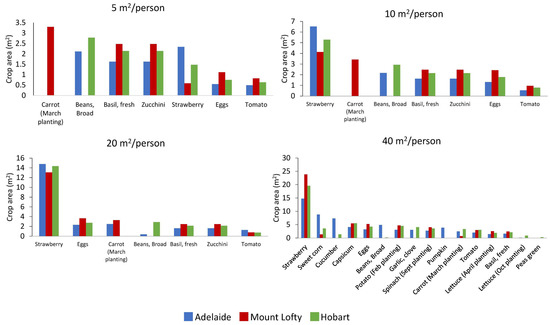
Figure 4.
Crops selected for small–medium gardens.
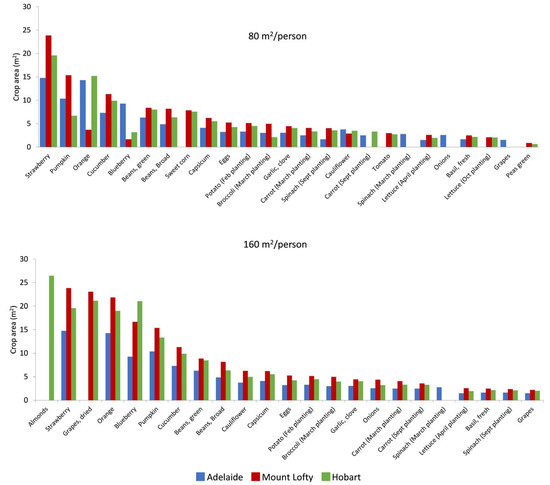
Figure 5.
Crops selected for large gardens.
Interestingly, zucchini is also common in all regions for gardens 20 m2/person or less, but is not selected for larger gardens (40 m2/person or more). This type of model behaviour was noted by [13] and was explained to be “due to complex interactions between seasonal availability of different crops and resultant optimal land allocation”.
It is important to note that as the garden size increases, the diversity of crops increases. In other words, the model does not simply identify a small number of highest-value crops and scale up the area allocation in proportion to garden size. The reason for this is the application of dietary food group constraints—allocating 80 m2/person to strawberry production, for instance, would deliver far more strawberries than a balanced diet could accommodate. The results here are heavily dependent on the diversity of crops included in the analysis which the model can choose between.
Essentially, the smaller gardens have an economic advantage in that they can direct their area towards the highest-performing crops, while larger gardens must diversify into lower-performing crops. Figure 6 shows the net financial value of garden produce (retail value minus cost of water and other inputs) per unit area. This negative slope illustrates the financial cost of diversification in larger gardens. Interestingly, at small garden sizes, the model predicts that substantially higher net value can be theoretically achieved in Adelaide than either of the other two locations, despite Adelaide having the highest water price and the greatest irrigation requirement. The reason for this is that—in small gardens—the optimisation selects from very high value crops (such as strawberries and eggs) that offer a high net return that is insensitive to water price. The return per square metre then scales largely in proportion to total yield, which is assumed to be proportional to total ET over the growing period. As the garden size increases, the model must select crops with a lower net value, and therefore Adelaide’s higher ET is offset by lower financial returns. At 80 m2/person, the gap is almost closed between the different locations, and at 160 m2/person the order has reversed with Hobart offering the highest net return per area.
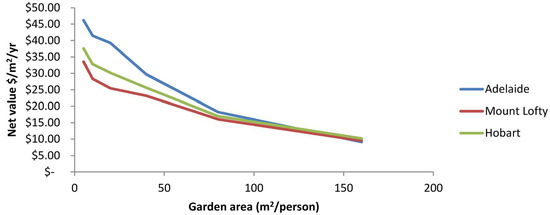
Figure 6.
Net value per unit area for different garden sizes. “Garden area” is the area allocated to the garden, but in the case of Adelaide, at 160 m2/person the actual utilised garden area was less than the allocated.
4. Discussion
There is much discussion about land constraints for UA, but little evidence to suggest that practitioners are selecting the best crops to (profitably) make use of what land they have. The modelling here suggests that there are certain crops (such as pumpkins, green beans and broccoli) which are really only suited to gardens with plentiful space, and which would be inefficient to grow in smaller gardens. In fact, in the case of the largest garden (160 m2/person), for the case of Adelaide weather, the model did not actually utilise the whole garden area in its optimal solution. The reason was that a combination of high water requirements and high water price meant that many of the lower-value crops would simply result in a net loss of money, and therefore, once the higher-value crops had reached the limits imposed by the dietary constraints, the optimal solution could not be improved upon by expanding the growing area. The result is interesting, and suggests that—at least in some cases—it is the finite “space” within a balanced diet (i.e., our inability to consume unlimited volumes of high-value crops such as fresh herbs) that limits UA expansion, rather than lack of sufficient land. In Hobart, meanwhile, the combination of slightly lower water requirement with significantly lower water price (relative to Adelaide) meant that the greater area could be utilised. Crops such as almonds, which had a net negative financial return in Adelaide’s climate (and were therefore excluded), were profitable and could be allocated to a substantial area in Hobart, thus using up the garden space.
Figure 7 shows the irrigation application rate (mm/year or L/m2/year) by garden size and location. The very smallest gardens lead to the selection of a small range of high net value crops, in which the high net value is driven by very high retail value rather than water-efficiency. At slightly larger garden sizes, the net value of crops is driven more by water efficiency than high retail value. Water use reaches a minimum at garden sizes 10–20 m2/person. As garden size increases beyond 20 m2/person, the diversification into lower value, less water-efficient crops is accompanied by more water use per unit area overall. The water use results suggest that an alternative optimisation model could be developed to find the optimum garden area (per person) to minimise garden irrigation, with implications for planning.
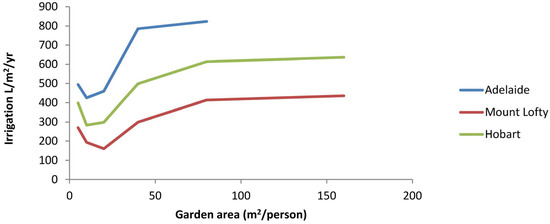
Figure 7.
Irrigation rate per unit area for different garden sizes.
Interestingly, the highest water use in Mt. Lofty (occurring for the largest gardens) roughly corresponds to the minimum water use in Adelaide. In a water-scarce city, the results from Figure 6 and Figure 7 may point to the preferred approach being relatively small garden sizes (10–20 m2/person), focusing on high-value, water-efficient crops. Figure 8 shows the net value of produce per kL of water applied. Here, we see the small gardens (10–20 m2/person) delivering the highest return on water. However, it can be seen that even in Adelaide, with the driest climate and highest water cost, there will be more than 10-fold net return on the cost of water for gardens up to about 40 m2/person, so long as the choice of crops is optimised.
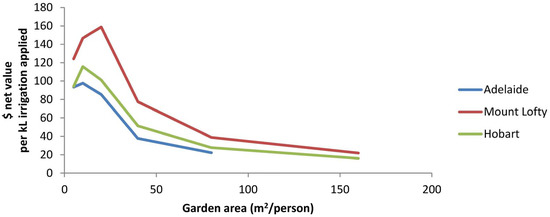
Figure 8.
Productivity ($/kL) of irrigation water for different garden sizes.
It is very interesting to see the wide gap between Mt. Lofty and Adelaide in Figure 6, Figure 7 and Figure 8. In terms of irrigation application (Figure 7), Mt. Lofty requires much less water due to its higher rainfall and lower ET0 (Figure 3). Meanwhile, in terms of total net value produced (Figure 6), Mt. Lofty sits well below Adelaide because of assumed reduced yields due to lower growing season ET0 (Figure 3). However, when we bring water use and net value together in Figure 8, we see that the reduced water use overwhelms the reduced yield, and the net productivity (value returned per kL) is substantially higher for Mt. Lofty than Adelaide. This suggests that although the crops selected might be broadly similar, to avoid disappointment among UA participants, the benchmarks or targets for garden performance should be appropriate to the local climate.
The only animal product included in the urban zone in this model was chicken eggs, and this was assumed to occupy its own discrete area (6 m2/chicken). Future iterations of the model, however, are envisaged where land area is at least partly shared e.g., chickens ranging under orchard trees, and even simulating the benefits of integration, such as chicken manure used for fertiliser. Other integrated, multi-purpose production systems could be included such as bees (for honey and enhanced pollination) and aquaponics (for fish meat and nitrogenous plant fertiliser).
5. Conclusions
Augmenting personal food supply in urban settings (UA) has long been popular and even received government backing during World War 2 (via so-called “Victory Gardens”), but waned in use in the post war period. Recently, however, it appears that UA is increasing in popularity. One of the reasons for this popularity is the potential to reduce food costs. However, the net cost of UA has not been studied, especially accounting for the cost of water. This study has sought to remedy this gap in the literature by examining the varying price of water in different—albeit similar—climates with conservative application rates to avoid potential underestimation of irrigation requirements as well as conservative crop yield estimates.
Linear programming has been used to model the profitability of UA, as it is a suitable method to solve complex problems yet is relatively simple to construct, is flexible and improves the quality of decision making. Linear programming usually includes an objective function, constraints and decision variables. A two-stage objective function was utilised in this study, with the first used to identify a group of near optimal solutions to minimise food costs and the second to maximise net value from this initial group of solutions. The decision variables were the type and amount of crops planted, while the constraints were constructed on the assumption that the food produced would contribute to a balanced diet which led to upper and lower bounds of dietary food groups, individual foods, protein and energy as well as area utilised per person.
The results of this model show that optimal crop regimes are quite similar across different climates and different local water prices, due to the selection of crops that have high profit margins (e.g., strawberries) even at very high water prices.
The results also showed that per capita garden size is critically important, and food gardens in the range 10–20 m2/person appear to be optimal in terms of water applied per unit area and net value returned per kL of water applied. In terms of overall return ($ net value) per unit area, the results suggest the smaller the garden, the better the return, due to the ability to select the highest value crops; however, these crops cannot be simply scaled up to larger gardens—once the diet has enough of the high-value items there is no choice but to select lower-value ones. As a general rule, the model showed that the more high-value and low water-use crops that can be included, the higher the productivity can be in larger gardens (where the optimisation is currently running short of high-value crops). These findings provide a proof of method, but are heavily dependent on the diversity of fruits and vegetables considered in the analysis with considerable scope to include a wider variety in future iterations of the model.
The paper has demonstrated a simple optimisation method that can be readily extended in other climates and water price scenarios, and can be modified to include a wide range of crops. The results indicate that even in a climate as dry as Adelaide with its high water prices, a modest food garden growing the right crops can theoretically be highly cost-effective, even with conservative estimates of crop yields and water use.
The results of this modelling should be of interest to policymakers—particularly at the local government level—and the garden industry, as they indicate that food gardening need not be dismissed as a purely discretionary activity. Rather, the results point to food gardening being amenable to promotion as a potentially profitable use of surplus land, which can ease cost-of-living pressures in cities. The specific results of the optimisation—in terms of areas dedicated to each crop, and optimal total garden area per person—lend themselves to public dissemination by government and garden suppliers via garden design guides. Finally, the universal selection of chicken eggs across all solutions indicates that local governments should particularly promote (and absolutely not regulate against) the keeping of poultry as part of a profitable UA system.
Author Contributions
James Ward conceived and designed the model and ran the model to generate the results and performed initial analysis of the results. John Symons contributed further analysis and interpretation of the data. James Ward and John Symons wrote the paper.
Conflicts of Interest
The authors declare no conflict of interest.
References
- Blaylock, J.R.; Gallo, A.E. Modeling the decision to produce vegetables at home. Am. J. Agric. Econ. 1983, 65, 722–729. [Google Scholar] [CrossRef]
- Patel, I. Gardening’s Socioeconomic Impacts. J. Ext. 1991, 29, 7–8. [Google Scholar]
- Ghosh, S.; Vale, R.; Vale, B. Local food production in home gardens: measuring on-site sustainability potential of residential development. Int. J. Environ. Sustain. Dev. 2008, 7, 430–451. [Google Scholar] [CrossRef]
- Gray, L.; Guzman, P.; Glowa, K.M.; Drevno, A.G. Can home gardens scale up into movements for social change? The role of home gardens in providing food security and community change in San Jose, California. Local Environ. 2014, 19, 187–203. [Google Scholar] [CrossRef]
- Ward, J.; Ward, P.; Saint, C.; Mantzioris, E. The urban agriculture revolution. Water J. Aust. Water Assoc. 2014, 41, 69–74. [Google Scholar]
- Sanyé-Mengual, E.; Oliver-Solà, J.; Montero, J.I.; Rieradevall, J. An environmental and economic life cycle assessment of rooftop greenhouse (RTG) implementation in Barcelona, Spain. Assessing new forms of urban agriculture from the greenhouse structure to the final product level. Int. J. Life Cycle Assess. 2015, 20, 350–366. [Google Scholar]
- van Veenhuizen, R.; Danso, G. Profitability and sustainability of urban and periurban agriculture. In Agricultural Management, Marketing and Finance Occasional Paper No. 19; Food & Agriculture Organisation of the United Nations (FAO): Roma, Italy, 2007. [Google Scholar]
- Satzewich, W.; Christensen, R. SPIN-Farming Basics: How to Grow Commercially on Under an Acre; SPIN Farming LLC: USA, 2011; p. 114. [Google Scholar]
- Cleveland, D.A.; Orum, T.V.; Ferguson, N. Economic value of home vegetable gardens in an urban desert environment. HortScience 1985, 20, 694–696. [Google Scholar]
- City of Tucson Current Water Rate Schedules. Available online: http://www.tucsonaz.gov/water/rates (accessed on 7 April 2014).
- Wallin, C. Profitable Plants Digest. Available online: http://www.profitableplantsdigest.com/about/ (accessed on 7 April 2014).
- Gladek, E. Polydome: High Performance Polyculture Systems; InnovatieNetwerk: Utrecht, The Netherlands, 2011. [Google Scholar]
- Ward, J.; Ward, P.; Mantzioris, E.; Saint, C. Optimising diet decisions and urban agriculture using linear programming. Food Secur. 2014, 6, 701–718. [Google Scholar] [CrossRef]
- Clarke, F.G. The History of Australia; Greenwood Publishing Group: Westport, CT, USA, 2002. [Google Scholar]
- Davison, A. Stuck in a Cul-de-Sac? Suburban History and Urban Sustainability in Australia. Urban Policy Res. 2006, 24, 201–216. [Google Scholar] [CrossRef]
- Gaynor, A. Harvest of the Suburbs: An Environmental History of Growing Food in Australian Cities; University of Western Australia Press: Crawley, WA, Australia, 2006. [Google Scholar]
- AUSVEG. Australian Vegetable Industry Strategic Investment Plan 2012–2017; Horticulture Australia: Sydney, Australia, 2012. [Google Scholar]
- Grewal, S.S.; Grewal, P.S. Can cities become self-reliant in food? Cities 2012, 29, 1–11. [Google Scholar] [CrossRef]
- Jeavons, J. How to Grow More Vegetables: And Fruits, Nuts, Berries, Grains, and Other Crops Than You Ever Thought Possible on Less Land Than You Can Imagine; Ten Speed Press: Berkeley, CA, USA, 2012. [Google Scholar]
- Gommes, R. An Introduction into the Art of Agrometeorological Crop Yield Forecasting Using Multiple Regression; Food and Agriculture Organization of the United Nations, Crop Monitoring and Forecast Group: Rome, Italy, 2001. [Google Scholar]
- Steduto, P.; Hslao, T.; Fereres, E.; Raes, D. Crop Yield Response to Water; FAO Irrigation and Drainage Paper 66; Food and Agriculture Organization of the United Nations: Rome, Italy, 2012. [Google Scholar]
- Allen, R.G.; Pereira, L.S.; Raes, D.; Smith, M. Crop Evapotranspiration: Guidelines for Computing Crop Water Requirements; FAO Irrigation and drainage paper 56; FAO: Rome, Italy, 1998. [Google Scholar]
- NHMRC. Australian Dietary Guidelines; National Health and Medical Research Council: Canberra, Australia, 2013.
- Holmgren, D. Garden Agriculture: A revolution in efficient water use. Water J. Aust. Water Assoc. 2005, 32, 8–9. [Google Scholar]
- Mason, A.J. OpenSolver—An Open Source Add-in to Solve Linear and Integer Progammes in Excel. In Operations Research Proceedings 2011; Springer: Berlin, Germany, 2012; pp. 401–406. [Google Scholar]
© 2017 by the authors. Licensee MDPI, Basel, Switzerland. This article is an open access article distributed under the terms and conditions of the Creative Commons Attribution (CC BY) license (http://creativecommons.org/licenses/by/4.0/).